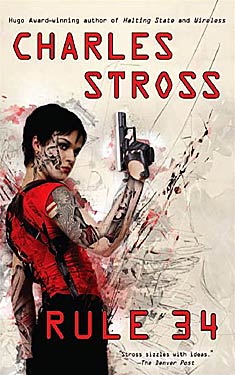Charles
Stross
Completed 7/17/2019,
Reviewed 7/17/2019
4 stars
This is a
sort of sequel to Halting State, a book I read several years ago for book club
and didn’t enjoy. What annoyed me most
about that book was that it was written in second person present and had an
awful lot of gamer jargon in it, most of which I didn’t understand. This book is similar to Halting State in that
it’s also written in second person and has a lot of computer and cop jargon, much
of which went over my head. But upon
rereading my review of Halting State, I found I liked this book for many of the
same reasons I hated that book. Whereas
I slogged through the first book, here I ate it up, finding it a quick exciting
read. And it was nominated for a
Gaylactic Spectrum Award in 2012 for positive LGBTQ content in genre fiction,
as well as for a slew of other science fiction awards.
 The story begins
with Liz Kavanaugh in Edinburgh, Scotland, one of the cops from the first book,
working in Rule 34 Squad, monitoring the internet for people engaged in illegal
activities. She gets assigned to a
suspicious death and soon finds that it is just one of several suspicious deaths
that all happened around the same time.
In the meantime, Anwar Hussein, recently out of prison, happens upon a
job as an honorary emissary for a new Asian republic that has declared
independence from Kyrgyzstan. But the
job doesn’t appear to be what one would think a consulate employee would
do. Coincidently, Liz collared Anwar in the
fake ID scam that landed him in jail. Lastly,
there’s John Christie, aka the Toymaker, who, also coincidently, was going to
do business with the first murder victim, which puts him on Liz’s radar. But are there really coincidences, and do all
these things add up to some more nefarious internet scheme?
The story begins
with Liz Kavanaugh in Edinburgh, Scotland, one of the cops from the first book,
working in Rule 34 Squad, monitoring the internet for people engaged in illegal
activities. She gets assigned to a
suspicious death and soon finds that it is just one of several suspicious deaths
that all happened around the same time.
In the meantime, Anwar Hussein, recently out of prison, happens upon a
job as an honorary emissary for a new Asian republic that has declared
independence from Kyrgyzstan. But the
job doesn’t appear to be what one would think a consulate employee would
do. Coincidently, Liz collared Anwar in the
fake ID scam that landed him in jail. Lastly,
there’s John Christie, aka the Toymaker, who, also coincidently, was going to
do business with the first murder victim, which puts him on Liz’s radar. But are there really coincidences, and do all
these things add up to some more nefarious internet scheme?
So yes, the
book is written in second person present. Unlike the first book, I found it easy to keep
my head in the characters. The point of
view changes with each chapter, but for some reason, I kept the characters
clearly delineated. The jargon was also
pretty overwhelming, but I was able to stick with it and got the gist of what
was going on. Lastly, the use of Scottish
words like “nae” and “ken” was a bit confusing, but I was able to handle that
as well. Somehow, I hit the tipping
point of understanding this book whereas I didn’t in its predecessor.
At its core,
this book is a police procedural. It’s gritty
and complex. It’s set in the near future. Despite the self-driving cars and the internet
glasses with terrific download speeds, you get the feel that this could be
happening today.
For me it
was the characters that made this book. I
really like the hapless Anwar.
Everything was always going wrong for him. Yet he was likeable in his schlemiel-ness. He’s a closeted gay man who’s married to a
woman and has two children. He does
programming on the side for his brother-in-law for a sketchy dating site. And he simply has a propensity towards making
bad choices. What’s not to like?
I give this
book four stars out of five. I read it
voraciously, even though it was difficult reading. I don’t know if it was actually written better
than the first book, or if I was just in a better mindset for multi-character
second person perspective. It just
struck me as a much better book even though I still had to work hard at keeping
up with the jargon. I think maybe too
the characters voices were better than in the first book. And lastly, I might have had a better
perspective myself going into this book because I saw the author at Westercon a
few years ago and he was a hysterical panelist.
Nice post thank you Jason
ReplyDeleteThanks, but who's Jason?
ReplyDelete